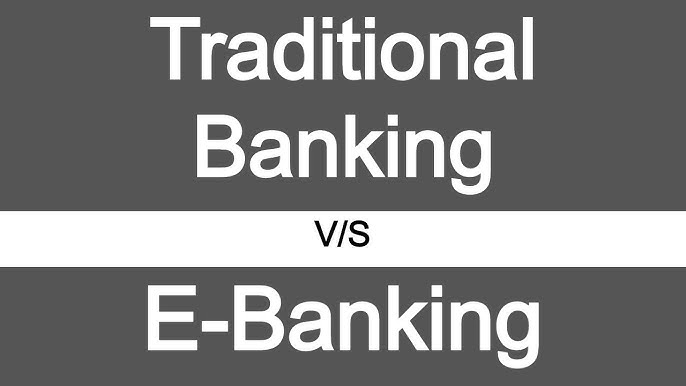In today’s fast-paced digital world, banking has evolved significantly. Traditional banking, which once required customers to visit a physical branch for most services, has given way to the convenience of online banking, where financial transactions can be conducted from the comfort of one’s home or on-the-go. While both forms of banking offer similar services, the way they operate and the experience they provide differ considerably. Understanding the key differences between traditional banking and online banking is crucial for individuals seeking to make informed decisions about managing their finances.
In this article, we’ll compare these two banking models, looking at aspects such as convenience, customer service, accessibility, fees, and security, among others.
What Is Traditional Banking?
Traditional banking refers to the banking services that are provided through physical branches and in-person interactions. In traditional banking, customers visit local bank branches to carry out most of their financial transactions, such as making deposits, withdrawing cash, opening accounts, or seeking financial advice. These banks offer a wide range of services including checking accounts, savings accounts, loans, credit cards, and investment services, all of which require in-person or phone interactions to complete.
While some traditional banks have incorporated digital services in recent years, the majority of their services are still delivered through face-to-face customer service at physical locations.
What Is Online Banking?
Online banking, also known as internet banking or e-banking, allows customers to access and manage their bank accounts and conduct financial transactions via the internet. Customers can perform a wide range of banking activities without visiting a physical branch. Online banking can be accessed using a computer, smartphone, or tablet, making it a highly convenient and accessible option for managing one’s finances.
Today, most banks offer online banking platforms, and many digital-only banks operate entirely on the internet without any physical branches. Online banking has revolutionized how people manage their money, offering a level of flexibility and ease that traditional banking often cannot.
Key Differences Between Traditional Banking and Online Banking
1. Convenience and Accessibility
Traditional Banking:
- Limited hours: Traditional banks typically operate during business hours (usually Monday to Friday, 9 AM to 5 PM). If you need to perform banking tasks outside of these hours, you will need to wait until the next available business day.
- Physical visits required: For many banking services (e.g., depositing checks, opening accounts, meeting with a financial advisor), you must visit a physical branch.
- Fewer locations: Depending on where you live, you may not have easy access to a local branch of your bank.
Online Banking:
- 24/7 accessibility: Online banking allows you to access your accounts and perform transactions anytime, anywhere. As long as you have an internet connection, you can manage your finances around the clock, including weekends and holidays.
- Global access: As long as you’re connected to the internet, you can access your online banking account from anywhere in the world. This is particularly beneficial for people who travel frequently or live in remote areas with limited access to physical bank branches.
- Mobile banking apps: Most online banks and traditional banks that offer online services have mobile apps, making it easy to conduct transactions on the go.
2. Customer Service
Traditional Banking:
- In-person interactions: If you have a question or need assistance with a banking issue, you can visit the branch and speak directly to a bank representative. This personal interaction can be comforting for customers who prefer face-to-face communication.
- Longer wait times: Depending on the branch, you may experience long waiting times, especially during busy hours. This could mean waiting in line to speak to a teller or schedule an appointment.
- Personalized advice: Traditional banks often offer in-person consultations with financial advisors who can help with financial planning, investment options, and loans.
Online Banking:
- Limited face-to-face interactions: With online banking, you primarily interact with automated systems, customer support chatbots, or email. While some banks offer video calls or chat support, they may not be as personal as in-person interactions.
- 24/7 customer support: Online banks often provide round-the-clock customer support via live chat, phone, or email. This is particularly beneficial if you need assistance outside traditional banking hours.
- Less personalized advice: While some online banks may offer financial planning tools or consultations, the experience is generally more automated and may not offer the same depth of personalized advice as traditional banks.
3. Fees and Charges
Traditional Banking:
- Monthly fees: Many traditional banks charge maintenance fees for having an account or maintaining a minimum balance. Some fees can also be incurred for services like check writing, ATM usage, and overdrafts.
- ATM fees: If you need to withdraw money from an ATM outside your bank’s network, you may incur additional charges.
- Paper-based services: Services like paper statements, checkbooks, and in-person consultations might come with extra fees.
Online Banking:
- Lower fees: Online banks tend to have lower fees compared to traditional banks. They often eliminate many of the common fees associated with traditional banking, such as account maintenance fees, ATM withdrawal fees (if they are part of a network), and paper statement charges.
- Free ATM access: Some online banks provide access to a vast network of ATMs or reimburse ATM fees, making it easier to withdraw money without incurring additional charges.
- No branch overhead costs: Since online banks do not maintain physical branches, they can pass on the cost savings to customers in the form of lower fees or better interest rates.
4. Security
Traditional Banking:
- Physical security: Traditional banks invest heavily in physical security, including safes, vaults, and security personnel to protect their assets. In addition, banking transactions that occur within the branch are inherently more secure due to the controlled environment.
- Face-to-face identity verification: When performing certain actions, such as withdrawing large sums of money or opening an account, you may need to show identification in person, reducing the risk of fraud.
Online Banking:
- Cybersecurity measures: Online banks rely on cybersecurity technologies such as encryption, multi-factor authentication (MFA), and firewalls to protect users’ data. While these measures are highly effective, the risk of hacking, phishing, or other online threats is still present.
- Two-factor authentication: Many online banking systems use two-factor authentication (2FA), requiring customers to verify their identity via a secondary device or method (e.g., a code sent to their phone), which adds an additional layer of security.
- Security risks: While online banking has strong security measures, users must also be vigilant against phishing schemes, malware, and unsecured Wi-Fi networks when accessing their accounts online.
5. Speed and Efficiency
Traditional Banking:
- Slower processes: Traditional banking can sometimes be slower, especially when it comes to processing transactions like transfers or cheque deposits. For example, you may need to wait for hours or even days to process certain transactions or clearances.
- Manual paperwork: Many traditional banking activities, such as loan applications or account setups, require filling out paperwork, which can slow down the process.
Online Banking:
- Instant transactions: Online banking provides quicker access to account balances, transfers, bill payments, and other services. You can often complete transactions in real-time, without waiting for office hours.
- Automated features: Online banking platforms often have automation features like scheduled bill payments, alerts, and account monitoring, which can save time and reduce manual effort.
6. Technology and Innovation
Traditional Banking:
- Limited digital features: While traditional banks have embraced some digital tools, such as mobile apps and online account access, their technological offerings may not be as comprehensive or cutting-edge as online banks.
- Slower adoption: Traditional banks often implement new technologies more slowly due to their reliance on established processes, regulatory concerns, and infrastructure.
Online Banking:
- Tech-driven services: Online banks often lead in the adoption of innovative technologies, such as artificial intelligence (AI) for customer support, blockchain for secure transactions, and advanced financial management tools.
- Seamless user experience: Online banks are designed to offer intuitive, user-friendly platforms and mobile apps that make managing finances easier and more efficient.
Conclusion
The key differences between traditional banking and online banking come down to convenience, cost, and accessibility. Traditional banking offers a more personal and tactile experience, with in-person services and advice that some customers still prefer. On the other hand, online banking provides the flexibility of managing finances from anywhere, at any time, with lower fees and faster transaction processing.
Choosing between the two depends on your personal preferences, banking habits, and the level of customer service you require. For those seeking convenience, low fees, and speed, online banking is often the better choice. However, for individuals who prefer face-to-face interactions, personalized service, and are less comfortable with technology, traditional banking may be the more fitting option.
Ultimately, the banking landscape continues to evolve, and many individuals are now combining the best of both worlds by using a mix of traditional and online banking services.




